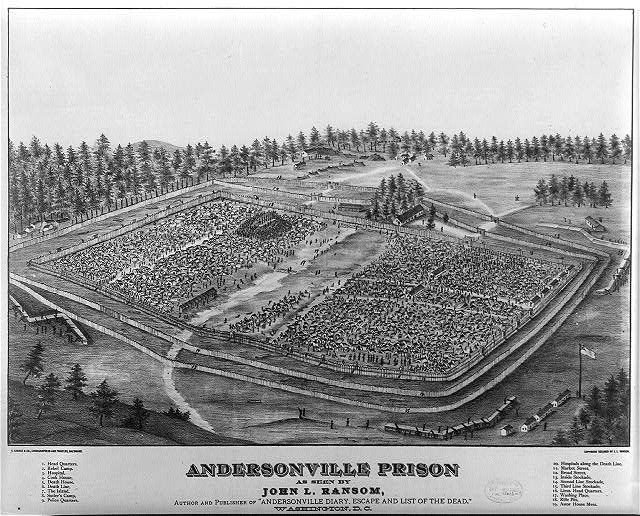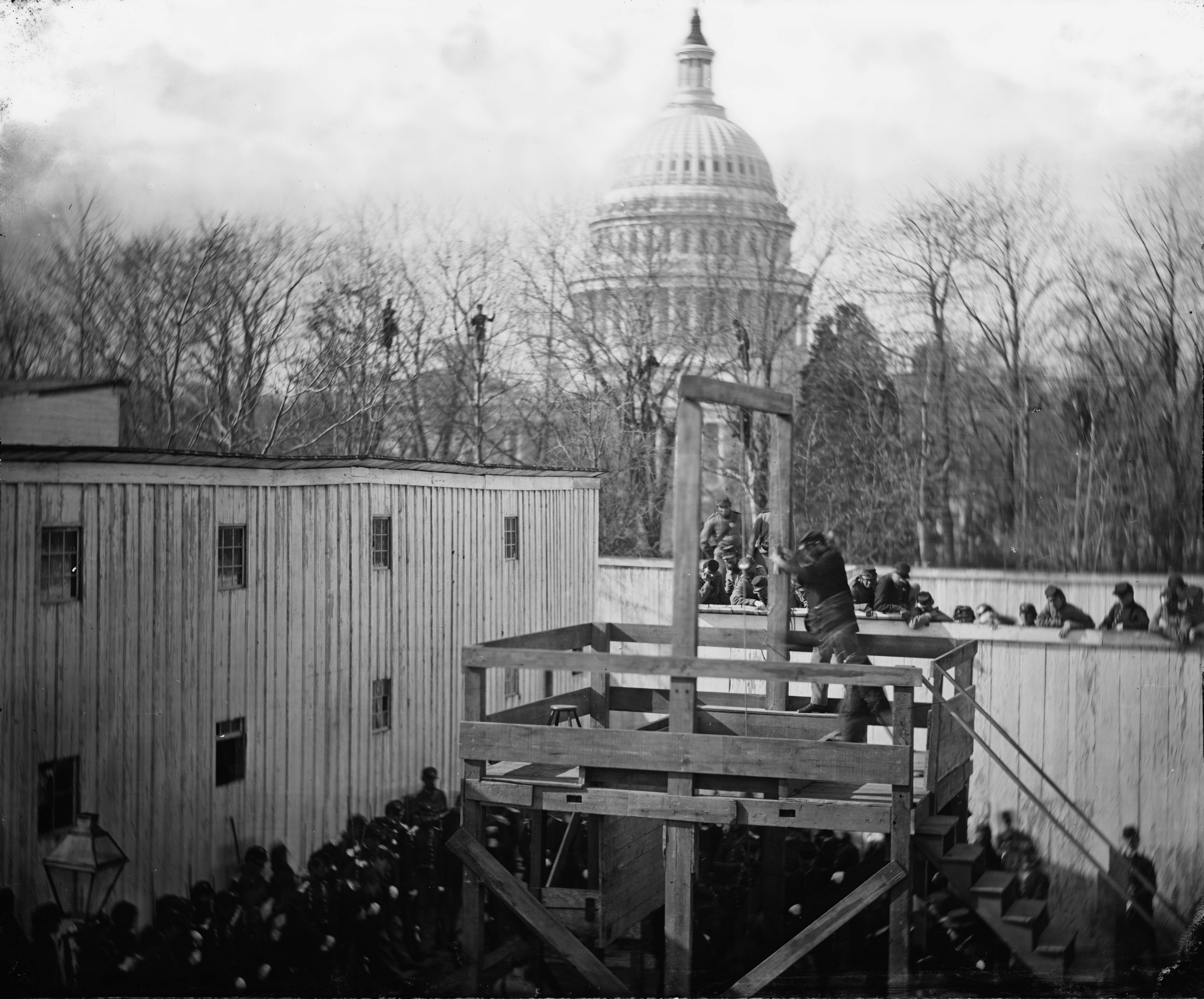On the 6th I was part of a PME (Professional Military Education - a formalized system of continuing training and education in the military) trip that went to Andersonville, GA. Most of you should recall the name as the infamous prison for Union soldiers during the American Civil War. Located in southern Georgia, it was away from the fighting and had ample resources to create and (theoretically) sustain the camp. Unfortunately for POW and all sides of the conflict, all resources for the Union and Confederacy were funneled directly to winning the war, and not to feeding or caring for 10's of thousands of POWs. When the Union opted out of the exchange of prisoners of war on April 17, 1864, the Union prisoner population only began to grow. With a Peak population of about 33,000, the 26.5 acres were packed elbow to elbow. Overall, there were about 45,000 prisoners that were sent to Camp Sumter and the overall death toll was 12,913. The dead were buried in mass graves with a meager identification marker for each man. Through the efforts of a Union soldier who worked in the camp hospital and recorded the names of the dead named Dorence Atwater and Clara Barton the men were given proper burials after the war. Through their herculean efforts, there are only 921 Unknown soldiers buried out of the nearly 13,000 that died there. Pretty impressive considering the death rate and the fact that Atwater had to hide the list (even from the US congress after the war - but that is another story.)
Here are some pictures:

Earthworks still remain.

A recreation of one corner of the stockade and living area. The man with the hat was our guide.

The prisoner cemetery

Note how close they are buried together.

From the New York Monument in the cemetery

A drawing of the camp in operation

An actual photo from August 17, 1864.
The rest of my photos are here.
Posts: 0
Threads: 0
Joined: Jan 2006
Nice pics. Capt. Todd. A thought came to me as I looked at ALL OF THEM. I wondered if you, Capt., could combine two or three of these pictures with two or three of WW 11 and two or three of the present. What a sight that would be. Yes men suffered in all three generations. Rocky
Posts: 0
Threads: 0
Joined: Nov 2007
Nice pics. Capt. Todd. A thought came to me as I looked at ALL OF THEM. I wondered if you, Capt.,
could combine two or three of these pictures with two or three of WW 11 and two or three of the
present. What a sight that would be. Yes men suffered in all three generations. Rocky
Well, not only were there men from the Civil War, but there were also US servicemen from that time to the present. It is a active cemetery and there were two funerals the day we visited. Here are some of the photos I took:

A 3 war vet (kinda sums up what you were talking about, right?)

This is a memorial becuase they were never able to recover the body.

Our guide and the more modern graves (note the space in between as opposed to the Andersonville prisoner ones.)
Forgot to add in this interesting story. Our dear Darlene may know the story about the Andersonville Raiders but I didn't. They were a gang of criminals who robbed and killed fellow prisoners. Eventually, the rest of the prisoners asked the Officer in charge of the prison, Capt Wirz, permission to begin a police force called the Regulators. Eventually, they captured the raiders and the ring leaders. Wirz gave permission to try the perpetrators. The bulk of them were forced to run the gauntlet (men with clubs on each side) and the 6 ring leaders were hung in the prison. Here is a picture of the ringleaders' graves:

They were buried away from the rest of the soldier population.
Posts: 0
Threads: 0
Joined: Oct 2007
TNT made a movie several years ago called "Andersonville" that is pretty accurate. There was a trial held among the prisoners and the raiders were assigned lawyers.
http://www.trutv.com/library/crime/notorio...onville/5.html#
Andersonville is truely an amazing place. Well worth the drive.
Posts: 0
Threads: 0
Joined: Jun 2004
Interesting post with photos. I didn't know the story re the Regulators either.
Marion J Chard
Proud Daughter of Walter (Monday) Poniedzialek
540th Engineer Combat Regiment, 2833rd Bn, H&S Co, 4th Platoon
There's "No Bridge Too Far"
Posts: 0
Threads: 0
Joined: Nov 2007
TNT made a movie several years ago called "Andersonville" that is pretty accurate.
Yes, We watched this on the on the way to and from the park. I thought that although it did give an fairly accurate portrayal of what went on their, the actor portraying Capt Wirz was pretty over the top.

Also, it seemed as if he had more of a Cuban accent rather than one from Switzerland (the actor, Jan Tříska, is from Prague which could explain it a little bit). It just seemed obvious that the producers were going out of their way to make him the bad guy. Even if he had the greatest of intentions, the conditions wouldn't have improved much as he did not have the resources to shelter, feed, or water the prisoners. After the war, he was tried and hung as the responsible party because the General who was in charge of the prison systems had died of a heart attack (lucky break for him).

Unfortunately for Wirz, in addition to the outrage about the deaths at Andersonville, Lincoln had just been assassinated, so sympathies for the south were few. I'm no Wirz apologist, but it does seem as though the man got railroaded. The only man to be tried and executed following the Civil War, his action were not much different than those of Union controlled prisons whose death rates were not much better. Andersonville just happens to have been the biggest of all of the prisons, north or south, so attention was focused on it. This strikes me as very similar to the reluctance on the part of the United States to pursue any of the officers or men responsible for crimes during WWII or other wars (save Iraq, of course - thank you Mr. Murtha.)
Bottom line: Would I put up a memorial to the man in the town square (like the one in the town of Andersonville), no. But nor do I think he should have been hung.

Posts: 0
Threads: 0
Joined: Jun 2004
Unfortunately, as was time and time again in history, a few men were chosen to cover and pay for the crimes of many. Others simply walked away, or as in this case, the guy died and didn't have to pay the price.
Marion J Chard
Proud Daughter of Walter (Monday) Poniedzialek
540th Engineer Combat Regiment, 2833rd Bn, H&S Co, 4th Platoon
There's "No Bridge Too Far"
Posts: 0
Threads: 0
Joined: Nov 2007
Others simply walked away, or as in this case, the guy died and didn't have to pay the price.
To me, if this was the standard of justice, so be it. Too often, however, the human need for at least symbolic justice mean that a few (or perhaps one) die for the crimes of many.
Posts: 0
Threads: 0
Joined: Oct 2007
At the end of the war, there was a lot of revenge seeking. Mary Surratt was a good example. She was hung as a Lincoln Conspirator. The evidence against her was sketchy at best, but they hung her. Several years later, they caught her son John who was by far more involved with Booth and the plot to kidnap Lincoln and he got off.
Posts: 0
Threads: 0
Joined: Nov 2008
I would definately recommend a visit to Andersonville for those that have not visited. It really shows how horrible the Civil War was. I recall reading about how a Tennessee Unionist who was held at Andersonville responded when a former Confederate veteran was going to be the pastor of his church. This CS veteran happened to serve in the regiment that captured the Union soldier, and his regiment. The Union vet objected to the selection of the pastor, and when told to forgive, he was quoted as saying, "The Lord was only crucified, he never had to spend time in Andersonville!". There are over 700 Tennessee Unionists buried in the Andersonville Cemetery.
Actually, there was another man tried and convicted during the war for war crimes. He was Champ Ferguson, and was a noted guerilla fighter. He was active in the Tennessee/Kentucky area, and was notorious for murdering any Federal soldier he captured, even shooting to death one who was laying in his hospital bed. There is a book that has been recently published about him recently.
|








